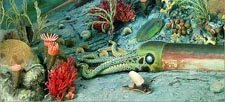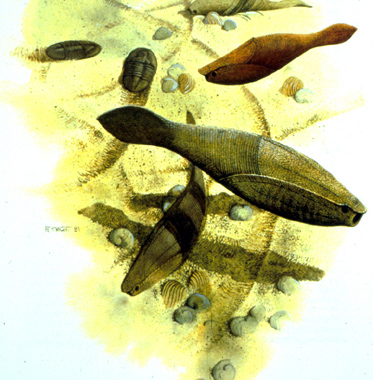 |
 |
 |
 |
 |
Produced
by the Population Genetics and Evolution class, Furman University |
||||
 |
 |
 |
 |
 |
Produced
by the Population Genetics and Evolution class, Furman University |
||||
 |
The
Ordovician: Arandaspis |
 |
||
| Arandaspis
prionotolepis is an extinct species of jawless fish that is one of
the oldest known vertebrates (Wikipedia 2010); predated only by the putative
Cambrian craniate from China, Myllokunmingia. The first remains
of Arandaspis were found in Alice Springs, Australia in 1959
and was named after a local Aboriginal tribe called the Aranda (Wikipedia
2010). These fossils were the first Ordovician remains found in the Southern
Hemisphere (Australian Heritage Places Inventory 2010). Arandaspis
was about 15 cm long (Wikipedia 2010). It is characterized as having a
streamline shaped body covered by drop shaped scales and pad-shaped, diphycercal
tail (Janvier 1997). The head and the front of the body are covered by
a “flat dorsal shield and a bulging ventral shield” with the
eyes and nostrils located at a notch in the anterior end of the dorsal
shield (Janvier 1997). There were also two small openings at the top of
the dorsal shield which are hypothesized to be light sensory organs (Australian
Heritage Places Inventory 2010). It is speculated that Arandaspis
also had up to fifteen gill openings that were between the dorsal and
ventral shield (Janvier 1997). Arandapsis had no jaws, but it did have
a ventral lip covered in small oral plates (Janvier 1997). The low position
of its mouth suggests that this fish was a bottom feeder (Wikipedia 2010).
These fish were eventually replaced by fishes with jaws and by modern
jawless Agnathans of today, such as hagfish and lampreys (Australian Heritage
Places Inventory 2010). Page by Chapin Hardy |
 |
| Picture from: www.bertsgeschiedenissite.nl | |
|
Australian Heritage Places Inventory. 2010. Central Australian Arandaspis Site. Accessed February 8, 2010. Janvier P. 1997. Arandaspida. Version 01 January Wikipedia. 2010.
Arandaspis prionotolepis. Accessed |